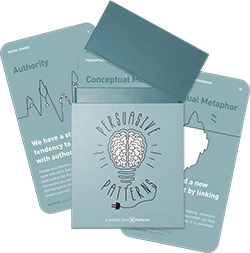Shaping
Design Pattern
Alternate titles: Conditioning.
Problem summary
Successively reinforce approximations to a target behavior
Usage
- Use to help users perform overwhelming behavior by breaking it down into smaller bits and gradually and successively approximate the target behavior, step by step.
This card is part of the Persuasive Patterns printed card deck
The Persuasive Patterns Card Deck is a collection of 60 design patterns driven by psychology, presented in a manner easily referenced and used as a brainstorming tool.
Get your deck!Solution
- Break down target behavior. When engaging in the desired behavior (e.g. talking in front of a big crowd) is too overwhelming, then break it down into smaller bits that start small and progressively build up into more complex behavior that gradually resembles the target behavior.
- Successively approximate. Start small (e.g. just standing on stake, then saying hello) to successively approximate and build up to the final desired behavior.
- Use to increase or decrease target behavior. Introduce rewards to increase a behavior and punishments to decrease a behavior. A reward can both be positive (adding a favorable event or outcome) and negative (removing of unfavorable event or outcome). Similarly can punishments be both positive (add unfavorable event our outcome) or negative (remove favorable event or outcome).
Rationale
Clearly define a target behavior with your users. Then design a program that rewards any response that in some way resembles the target behavior and gradually moves your reinforcement only to behavior that is closer to the target behavior until the final target behavior is achieved, which then is the only behavior to be rewarded.
The method of Shaping was introduced by B. F. Skinner with pigeons and extended to dogs, dolphins, humans and other species. The field of conditioning was also examined by Ivan Pavlov, although it differs from Skinner’s shaping as the reward came irrespective of the behavior of the animal.
1 Skinner, B.F. (1953). Science and human behavior. pp. 92–3. Oxford, England: Macmillan.
2 Peterson, G.B. (2004) A day of great illumination: B.F. Skinner’s discovery of shaping. Journal of the Experimental Analysis of Behavior, 82: 317–28
3 Operant conditioning at Wikipedia.org
User Interface Design Patterns
- Forms
- Explaining the process
- Community driven
- Tabs
- Jumping in hierarchy
- Menus
- Content
- Gestures
- Tables
- Formatting data
- Images
- Search
- Reputation
- Social interactions
- Shopping
- Increasing frequency
- Guidance
- Registration
Persuasive Design Patterns
- Loss Aversion
- Other cognitive biases
- Scarcity
- Gameplay design
- Fundamentals of rewards
- Gameplay rewards


